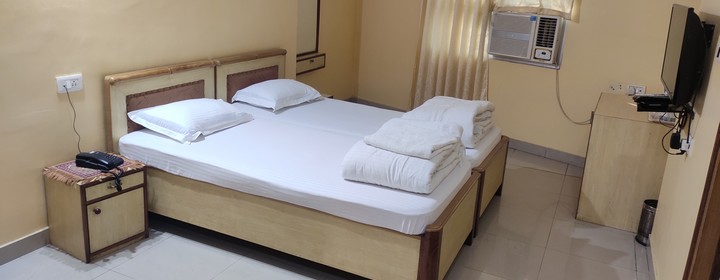Bodh Gaya - Place of Enlightment

Bodhgaya is one of the most important and sacred Buddhist pilgrimage center in the world. It was here under a banyan tree, the Bodhi Tree, Gautama attained supreme knowledge to become Buddha,the Enlightened One. Born; in the foothills of the Himalayas as a Sakya prince of Kapilvastu (now in Nepal), most of the major events of his life, like enlightenment and last sermon, happened in Bihar.
Buddhism as a religion was really born in Bihar and evolved here through his preaching and the example of his lifestyle of great simplicity, renunciation and empathy for everything living.Significantly, the state's name of 'Bihar' originated from 'Vihara' meaning monasteries which abounded in Bihar. Several centuries after Buddha's passing away, the Maurya Emperor Ashoka (234-198 BC) contributed tremendously towards the revival, consolidation and spread of the original religion. It is the monasteries, Ashoka built for the Buddhist monks and the pillars known as Ashokan Pillars erected to commemorate innumerable historical sites associated with the Buddha's life, mostly intact to this day, that helped scholars and pilgrims alike to trace the life events and preaching of a truly extraordinary man. There is a magnificent Mahabodhi temple and the Tree from the original sapling still stands in the temple premises. The temple is an architectural amalgamation of many centuries, cultures and heritages. While its architecture has a distinct stamp of the Gupta era, it has later ages inscriptions describing visits of pilgrims from Sri Lanka, Myanmar and China between 7th and 10th century AD. It is perhaps still the same temple Hieuen Tsang visited in 7th century.
Climate Of BodhGaya

Summer ::
BodhGaya, being located in tropical region, experiences hot summers. The maximum temperature goes up to 45 ºC. You must carry light cotton clothes while traveling to BodhGaya during summer months.
Monsoon ::
During the monsoon months (July to September), the entire region gets enormous rain. It is advisable to avoid traveling to BodhGaya and the surrounding areas during Monsoon months.
Winters ::
The period from October to March form the best time to travel to BodhGaya. During the months of November to February, the Mercury goes down and it is the most appropriate time to explore BodhGaya. Don’t forget to carry warm woolen clothes while traveling to BodhGaya in winters.
How To Reach BodhGaya

By Rail ::
The nearest railhead is Gaya and all the major trains pass through the station. Patna is another railhead from where you can board trains for other destinations in India. Patna is linked with all the major cities of India including the metros of New Delhi, Kolkata, Mumbai and Chennai. The Mahabodhi Express is a special train that runs between Delhi and Gaya daily and non-stop and takes just 16 hours to reach Gaya from Delhi.
By Road ::
Bodhgaya is well connected by road to Gaya (17km), Nalanda (101 km), Rajgir (78 km), Patna (135km), Varanasi (252 km), Calcutta (495km)
By Air ::
The nearest airport is at Gaya 7 Kms and Patna 135 kms. Indian Airlines and Sahara Airlines connect Patna to Calcutta, Bombay, Delhi, Ranchi, Lucknow and various other cities.
What To See

Mahabodhi Temple
The temple stands in the east to the Bodhi Tree. Its architectural effect is superb. Its basement is 48 square feet and it rises in the form of a slender Pyramid till it reaches its neck, which is cylindrical in shape. The total height of the temple is 170 ft. and on the top of the temple are Chatras which symbolize sovereignty of religion. Four towers on its corners rise gracefully giving the holy structure a poise balance. This sacred edifice is like a grand banner unfurled by time to proclaim to the world the pious efforts of the Buddha to solve the knots of human miseries, to ascend above worldly problems and to attain transcendental peace through wisdom, good conduct and disciplined life.
inside the temple, in the main sanctum, there is a colossal image of the Buddha in sitting posture touching the earth by his right hand. In this posture the Buddha accomplished the supreme enlightenment. The statue is of black stone but it has been guilder by the devotees. The entire courtyard of the temple is studded with large number of votive stupas. These stupas are of all sizes built during the past 2500 years ago. Most of them are extremely elegant in structural beauty. The ancient railings, which surround the temple, are of the first century BC and are among the very interesting monuments of the century.
Animesh Lochan Chaitya
It is believed that the Buddha spent one week here looking towards the great Bodhi tree out of gratitude, without twinkling his eyes.
Bodhi Tree
he present Bodhi Tree is probably the fifth succession of the original tree under which the Buddha had attained enlightenment. Vajrasana, the seat of stability, is a stone platform on which the Buddha is supposed to have sat in meditation gazing east, under the Bodhi tree.
Chankramana
This marks the sacred spot of the Buddha's meditative perambulations during the third week after pious enlightenment. It is believed that wherever the Buddha put his feet lotus sprang up.
Ratnagarh
The Buddha spent one week here, where it is believed that five colors came out of his body.
Other Treasures of BodhGaya
80 ft Statue of the Buddha, Lotus Tank, Buddha Kund, Rajayatana, Brahm Yoni, Chinese Temple & Monastery, Burmese Temple, Buddhist Monastery of Bhutan, International Buddhist House & Japanese Temple, Thai Temple & Monastery, Tibetan Monastery, Archaeological Museum. Sujata village (2 kms), Dungeshwari Hill (Prag bodhi) (22 kms by road), Maitraya Project (3 kms).




